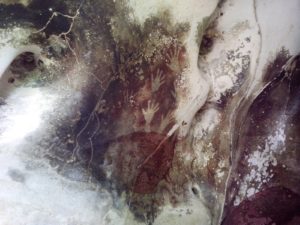
SCIENTIFIC REPORTS—Climate change may be accelerating the degradation of ancient rock paintings in Indonesia, including the oldest known hand stencil in the world which dates back to 39,900 years ago, according to a study* published in Scientific Reports.
Rock paintings made using red and mulberry-colored pigments in the limestone caves and rock shelters of Maros-Pangkep, Indonesia have been dated to between 20,000 and 45,000 years old. Anecdotal evidence suggests that the paintings have been deteriorating at an accelerated rate in recent decades, but the reasons for this have been unclear.
Jillian Huntley and colleagues investigated the potential causes of accelerated rock art degradation at 11 cave art sites in Maros-Pangkep, by analyzing flakes of rock that had begun to detach from cave surfaces. The authors found salts including calcium sulfate and sodium chloride in flakes of rock at three of the sites. These salts are known to form crystals on the rock surfaces, which cause the rocks to break apart. The authors also found high levels of sulphur, a component of several salts, at all 11 sites. The findings* may indicate that the process of salt-related rock art degradation is widespread in Maros-Pangkep.
The authors suggest that repeated changes in temperature and humidity caused by alternating periods of seasonal rainfall and drought create conditions that promote salt crystal formation and rock art degradation. They propose that these changes may be accelerated by rising global temperatures and the increasing frequency and severity of extreme weather events due to climate change and El Niño events. Long-term monitoring and conservation efforts are needed to protect ancient rock art in tropical regions, the authors conclude.
________________________________

Hand prints in Pettakere Cave at Leang-Leang Prehistoric Site, Maros. Cahyo, Creative Commons Attribution-Share Alike 3.0 , Wikimedia Commons
________________________________
Article Source: Scientific Reports news release
*The effects of climate change on the Pleistocene rock art of Sulawesi





